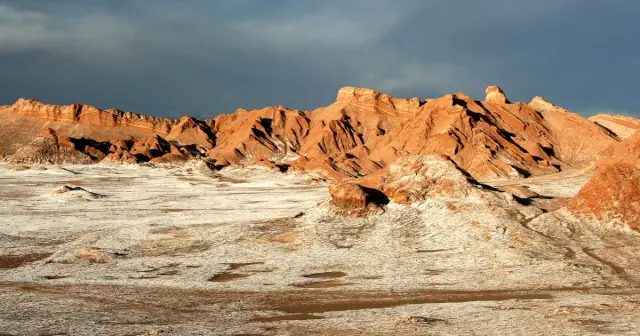Winter in Chile is characterized as the coldest season of the year, with significant variations depending on the region. There are two ways to define the beginning of this period: meteorological winter and astronomical winter. In 2025, winter will officially begin on June 21 , coinciding with the winter solstice. This period brings climatic changes in different areas of the country, as well as cultural traditions and activities related to skywatching.
Definition of winter in Chile
Winter in Chile is a season characterized by lower temperatures and, in many regions, increased rainfall. The country's geographical diversity significantly influences how this season is experienced.
Meteorological winter
Meteorological winter in Chile runs from June 1st to August 31st. This approach divides the year into four three-month seasons, which is useful for climatological studies. During this period, the coldest temperatures of the year are recorded, and rainfall patterns are observed in various regions.
Astronomical winter
Astronomical winter officially begins with the winter solstice, which occurs around June 21. This event marks the moment when the sun is at its lowest position in the sky, resulting in the shortest day and longest night of the year. Variations due to a country's geography influence the perception of this season.
When does winter begin in Chile? 2025
The arrival of winter in Chile is an event that marks a series of climatic and cultural changes. For the year 2025, the dates are especially significant, as they coincide with important astronomical phenomena.
Exact date
In 2025, winter will officially begin on June 21st. This date is set in accordance with other countries in the Southern Hemisphere and is based on the winter solstice, the time of year when the day is shortest and the night is longest. Depending on the year, the solstice can vary between June 20th and 21st, but in 2025 it will be clearly marked by the 21st.
Winter solstice: an astronomical event
The winter solstice is not just a calendrical milestone. From an astronomical perspective, this event declares the movement of the Sun to its lowest point in the sky. This results in a phenomenon that has captured the attention of civilizations throughout history. In the Chilean context, it represents the arrival of the cold season, which affects both the climate and the culture of the country.
The Mapuche community, for example, celebrates this time as We Tripantu, a new year that symbolizes the rebirth of nature and the return of the sun. This cultural connection underscores the importance of winter in the daily lives of Chileans and their relationship with the environment.
Climate change and its effects on winter
Climate change directly impacts the behavior of winter in Chile. These phenomena can alter the typical conditions expected during this season, affecting precipitation and temperature patterns.
Impact of climate change
Climate variations have begun to have significant effects on the Chilean winter. Winter temperatures have risen in some regions, which can lead to drier or less snowy conditions. This phenomenon has a significant impact on several aspects, including:
- Changes in water availability, both for human consumption and agriculture.
- Changes in the planting and harvesting season due to warmer, drier summers.
- Impact on biodiversity, where native and migratory species may see their behavioral patterns affected.
La Niña phenomenon
La Niña is a climate phenomenon that causes changes in rainfall patterns, with specific implications for winter. During La Niña episodes, the country can experience decreased rainfall in certain areas, while the south tends to receive more rain. The characteristics of this phenomenon can contribute to:
- Variability in the amount of snow accumulated in the mountains, affecting long-term water resources.
- Changes in ecosystems, where some species may benefit while others struggle to adapt to new conditions.
Winter forecasts and their climatic characteristics are crucial for anticipating these effects and ensuring proper planning across various sectors.
Climate conditions in different areas of Chile
Winter weather conditions in Chile vary significantly across the country's regions. These differences are due to geography, altitude, and proximity to the sea, which influence temperatures and precipitation.

Northern Zone
In the northern region, stretching from Arica to La Serena, the winter climate is calm and dry. Daytime temperatures can remain relatively high, but nights are often cold. Rainfall is scarce, with June and July being primarily arid months.
Central zone and Santiago
The central region, including the capital, Santiago, experiences colder winters. Temperatures can drop considerably, especially in the early morning. During this period, rainfall is frequent, contributing to the vitality of water reserves.
Valparaíso and its surroundings
This coastal region is characterized by a mild winter climate. Rainfall is more moderate compared to the central region, but is essential for the growth of a wide variety of crops in the interior.
From Araucanía to Los Ríos
In the south, these regions experience cold winters with abundant rainfall. The rains are intense and almost continuous, creating vibrant, green landscapes. Winter temperatures can drop, especially in higher elevations.
The Lakes and Aysén
These southern regions of Chile experience harsh winters, with temperatures that can reach extreme levels. Snow is common in higher altitudes, and rain is much more frequent, affecting both the climate and the daily lives of its inhabitants.
Social and economic importance of winter
Winter in Chile is not only defined by its climatic conditions, but also by its relevance to various social and economic areas. This season has significant implications for the country's population and economy.
Increased rainfall and water security
One of the most notable aspects of winter is the increase in precipitation, especially in the southern regions. This phenomenon is crucial for ensuring water availability throughout the rest of the year. Winter rains recharge aquifers and irrigation systems, contributing to more efficient water management.
- Rainfall is crucial for agriculture.
- They promote the generation of hydroelectric power.
- They are essential for the conservation of aquatic ecosystems.
Agricultural relevance
The impact of winter on the agricultural sector is considerable. Rainfall favors crop growth, ensuring food production. However, its irregularity requires farmers to adapt to weather conditions.
- Improves soil quality thanks to humidity.
- It allows the planting of species that require cold climates.
- Facilitates crop planning and the use of water resources.
Cultural traditions of winter
Winter in Chile is steeped in diverse cultural traditions that reflect the communities' connection to nature and their roots. These practices are essential to understanding the rich heritage of Indigenous peoples and their celebrations.
We Tripantu and indigenous peoples
We Tripantu, which translates as "new cycle" or "new year," is a cultural expression of the Mapuche people, where the winter solstice is celebrated. This event marks the rebirth of the sun and the renewal of life in nature. During this time, ceremonies are held that include rituals to thank the earth and the ancestors.
Families gather to share traditional foods, and bonfires are often lit, symbolizing the return of warmth and light. Music and dance are essential, creating an atmosphere of unity and reflection.
Celebrations and symbolism
In the context of winter, traditions go beyond We Tripantu. Many communities celebrate with events that highlight the importance of water and the earth, given the contemplation of the rains that bring abundance. The use of natural elements, such as stones and seeds, is common in various festivities, symbolizing the cycle of life.
- Collective ceremonies involve dances and songs that reinforce cultural identity.
- Gratitude rituals are activities that unite communities, causing them to reflect on their relationship with their environment.
Winter in Chile is a significant time to keep these traditions alive, celebrating the connection to the land and cultural memory.
Astronomical observations during the winter
Winter in Chile offers favorable conditions for observing the night sky. During this time, a greater number of celestial objects can be seen, attracting both amateur and professional astronomers.
Importance for astronomers
Winter is a crucial season for astronomy in our country. The tilt of the Earth's axis during these months allows for a better view of the Milky Way. The reduced amount of ambient light and atmospheric stability contribute to sharper and more precise observations. These conditions favor a wide range of activities, from stargazing to more detailed studies of galaxies and nebulae.
Celestial objects visible in winter
During winter, several celestial objects stand out in the Chilean sky. Some of them are:
- Milky Way: Its splendor is most evident at this time, offering a breathtaking view.
- Planets: Saturn and Jupiter are usually visible, allowing their rings and moons to be observed.
- Constellations: The Southern Cross and Orion are easily identifiable, serving as guides in the sky.
- Nebulae: The Orion Nebula and others can be observed with telescopes.
These observations not only enrich our understanding of the universe, but also foster a sense of connection with nature and the cosmos.
Frequently asked questions about winter in Chile
The arrival of winter in Chile raises several questions. Below are some of the most common questions about this season and its characteristics.
When does winter end in Chile?
Winter in Chile officially ends on August 31st. At the end of this period, spring begins, extending until November 30th. This transition marks a significant change in climatic conditions, with temperatures beginning to rise and vegetation beginning to bloom again.
What are the differences between meteorological and astronomical winter?
There are two ways to define winter: meteorological and astronomical. The main difference lies in the calendar:
- Meteorological winter in Chile begins on June 1 and ends on August 31. This classification is based on climatic criteria and allows for more precise statistical studies.
- Astronomical winter begins with the winter solstice, which usually occurs between June 20 and 21, and ends with the vernal equinox, around September 21.
What are the coldest months of the year in Chile?
The coldest months in Chile are typically June, July, and August. During these periods, the lowest temperatures are recorded across much of the country. However, conditions can vary depending on the region, with the south being more prone to colder temperatures and precipitation. In contrast, the north generally has a drier and more temperate climate.
